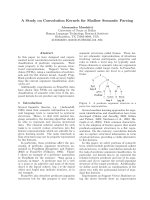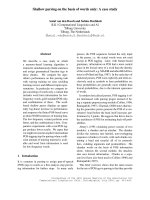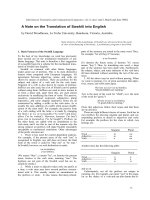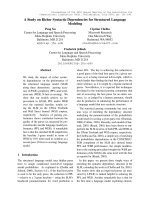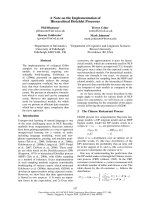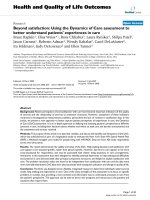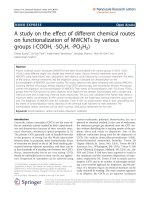Báo cáo thú y: "A study on the applicability of implantable microchip transponders for body temperature measurements in pigs." pptx
Bạn đang xem bản rút gọn của tài liệu. Xem và tải ngay bản đầy đủ của tài liệu tại đây (567.33 KB, 9 trang )
Lohse et al. Acta Veterinaria Scandinavica 2010, 52:29
/>Open Access
RESEARCH
BioMed Central
© 2010 Lohse et al; licensee BioMed Central Ltd. This is an Open Access article distributed under the terms of the Creative Commons
Attribution License ( which permits unrestricted use, distribution, and reproduction in
any medium, provided the original work is properly cited.
Research
A study on the applicability of implantable
microchip transponders for body temperature
measurements in pigs
Louise Lohse
1
, Åse Uttenthal
1
, Claes Enøe
2
and Jens Nielsen*
1
Abstract
Background: The applicability of an electronic monitoring system using microchip transponders for measurement of
body temperatures was tested in 6-week-old conventional Danish weaners infected with classical swine fever virus
(CSFV). Subcutaneous tissue temperatures obtained by the implantable transponders were compared with rectal
temperatures, recorded by a conventional digital thermometer.
Methods: In a preliminary study, transponders were inserted subcutaneously at 6 different positions of the body of 5
pigs. The transponders positioned by the ear base provided the best correlation to rectal temperature. To test the
stability of the monitoring system in a larger group of pigs, transponders were therefore inserted by the left ear base in
a subsequent infection experiment with 30 pigs.
Results: Generally, the microchip transponders measured a subcutaneous tissue temperature, which was about 1°C
lower than the rectal temperature. However, a simple linear relationship between the measures of the two methods
was found.
Conclusions: Our study showed that the tested body monitoring system may represent a promising tool to obtain an
approximate correlate of body temperatures in groups of pigs. In contrast, however, the tested system did not
constitute a suitable tool to measure body temperatures of individual animals in the present pig infection experiment.
Background
A major part of our research concerning viral infections
in domestic animals involves investigations of the host-
virus interaction based on infectious animal experimental
studies [1-3]. The clinical monitoring of these studies
inevitably includes registration of the animal's body tem-
perature. Our standard procedure to obtain these data is
to measure the rectal temperature using a digital ther-
mometer, if necessary under restraint of the animal.
Depending on the number of experimental pigs and the
frequency of body temperature measurements required,
the rectal recording method can be rather laborious and
time consuming. Furthermore, the restraint of the animal
may be stressful and compromise the well-being, leading
to a hyperthermic response, although usually of short
duration only [4]. In addition, the induced physical stress
may increase the plasma cortisol concentration in the
individual animal [4-6]. Since cortisol affects several
physiological parameters e.g. blood cell profile and serum
chemistry [6-8], stress-induced quantitative changes in
the level of this hormone may bias experimental results.
To circumvent these problems, we are interested in
alternative methods for body temperature monitoring in
large animals using a minimal invasive technique, which
in addition should be easy accessible, simple and fast in
use. As our experimental models mostly involve the por-
cine species, we found it appropriate to test, whether a
commercially available monitoring system would be
applicable for body temperature measurements in pigs.
Pigs are increasingly used for biomedical research and
advanced bio-telemetric equipment providing data of
specific physiological variables, e.g. blood flow and pres-
sure, ECG and body temperature, constitutes an opportu-
nity for recording the body temperature without human
* Correspondence:
1
National Veterinary Institute, Technical University of Denmark, Lindholm, DK-
4771 Kalvehave, Denmark
Full list of author information is available at the end of the article
Lohse et al. Acta Veterinaria Scandinavica 2010, 52:29
/>Page 2 of 9
interaction [9,10]. These systems, however, require surgi-
cal implantation for cardiac instrumentation.
A much more simple system using special ear tags with
integrated sensors to measure the ear skin temperature in
boars was tested by Bekkering and Hoy [11]. These
authors, however, found that the skin temperature of the
pig ear was not a reliable parameter for prediction of the
rectal temperature, and as such, this method did not rep-
resent a reliable tool to monitor body temperature in our
settings.
Thus, still looking for a system fulfilling our expecta-
tions, we have tested whether an electronic identification
and body temperature monitoring technology presently
applied in small experimental animals [12,13] could be
transferred for use in pigs. This system is based on a
radio-telemetric system using a programmable, inject-
able, microchip transponder with a built-in temperature
sensor combined with a hand-held scanner for data col-
lection. The system provides an opportunity to pro-
gramme the transponder with further data, e.g. animal
identification code, which can be linked to the tempera-
ture when recording. A few studies using this system have
previously been performed in large animals, i.e. horses,
goats, sheep [14] and pigs [15,16], with variable results.
In two animal experimental studies, already planned as
parts of ongoing national research activities, we therefore
wanted to compare microchip-based measurements of
subcutaneous tissue temperature with digitally recorded
rectal temperatures in pigs. Microchip transponders were
placed subcutaneously in 35 pigs, which were either inoc-
ulated with classical swine fever virus (CSFV) of high or
low virulence, respectively, or served as placebo-treated
uninfected controls. We used a pig model infected with
CSFV, a pathogen that may cause high fever, in order to
test the system in healthy as well as febrile animals.
Materials and methods
Animals
In total, 35 six-week-old pigs, weight 10 - 16 kg, were
obtained from a conventional Danish swine herd. At
arrival, all pigs appeared healthy by clinical examination.
All pigs were housed within the National Veterinary
Institute's high containment experimental facilities and
allowed to adapt to the new environment approximately
one week before the start of the experiment. All pigs were
fed once a day with commercial feed for weaning pigs and
water was provided ad libitum. Straw was used for bed-
ding. For experiment I, ambient temperature was not
fixed and ranged within a temperature interval of 18-
21°C. For experiment II, controlled heated air supply
maintained a constant temperature of 20 ± 1°C through-
out the experiment.
Virus
The following strains of CSFV were used for inoculation
in the experiments:
CSF0382: Koslov strain originating from the Czech
Republic, characterized to be of high virulence (kindly
supplied by the EU Community Reference Laboratory
(CRL) for CSF, TiHo, Hannover), [17].
CSF0911: Glentorf strain originating from Germany,
characterized to be of low virulence (kindly supplied by
CRL, Hannover), [18].
CSF1019: Romania TM/120/07 field isolate obtained
from domestic pigs, Romania 2007, characterized to be of
medium/high virulence (kindly supplied by Dr Olaru,
NRL, Romania and the CRL, Hannover).
All pigs were inoculated intranasally with a virus dose
of 10
5
TCID
50
/pig.
Electronic equipment
Bio Medic Data System (BMDS) (Plexx, the Netherlands):
This system comprised implantable programmable tem-
perature transponders (IPTT-300™) designed for non-
surgical implantation into animals. The microchip tran-
sponder is a passive (battery free) cylinder shaped with a
dimension of 2.2 × 14 mm placed in a needle assembly to
be injected subcutaneously. Reading of the transponder is
performed by a hand-held scanner (DAS 6007) to be ori-
ented in line with the transponder within a distance of
maximum 5 cm. Before insertion, transponders were pro-
grammed with the ID-number of the respective pig to
avoid interference from neighbouring pigs during data
collection.
Rectal temperatures were recorded with a digital ther-
mometer, accuracy ± 0.1°C (Kruuse, Denmark).
In a laboratory set-up, the accuracy of transponders
was tested against certified thermometers using a water
bath representing 3 different temperatures, i.e. 37, 39 and
41°C. Accuracy of measurements for 4 transponders was
found to be within the range of 0.1 - 0.4°C. In the animal
experimental facilities, the repeatability of measurements
of transponders within individual pigs was measured by
10 subsequent recordings in two randomly selected pigs.
Repeatability was found to be 0.1 - 0.5°C.
Experimental design
Experiment I
Five pigs were used. Microchip transponders were
inserted at 6 different locations of each pig: T1+T2) Left
and right ear base, respectively, below subcutis and asso-
ciated connective and fat tissue, close to the cervical mus-
culature. Left positioned transponder in vertical position,
right positioned transponder in horizontal position.
T3+T4) Ischio-rectal region. Left positioned transponder
superficially inserted under the skin, right positioned
transponder injected 1-2 cm into the depth of the ischio-
Lohse et al. Acta Veterinaria Scandinavica 2010, 52:29
/>Page 3 of 9
rectal fossa in cranio-caudal direction, parallel to rectum.
T5) Inguinal region, left side, transponder injected below
subcutis and associated connective tissue, into the fascia
close to the oblique abdominal musculature. T6) Neck
region, transponder injected from a right lateral position
1-2 cm into the connective tissue, close to the neck mus-
culature.
T1-T4 were inserted on post infection day (PID) -4, and
T5+T6 were inserted PID 0. Before injection of a tran-
sponder, the skin area to be involved (10 × 10 cm) was
shaved and surgically cleaned with 70% ethyl alcohol and
5% iodine, respectively.
On PID 0, all pigs were inoculated with CSFV-Koslov.
Blood samples were collected on PID 0, 1, 3 and 7 for hae-
matological and virological examinations.
Body temperature was recorded once a day with both
telemetric equipment and digital thermometer. Readings
for rectal temperature and microchip transponders, T1-
T4, were obtained from start (PID -4) and followed dur-
ing the entire experiment, while data for microchip tran-
sponders T5 and T6 were obtained from PID 0 and then
followed to the end of the experimental period at PID 7,
where all pigs were euthanized.
Experiment II
Thirty pigs were used. One microchip transponder was
inserted vertically, deep subcutaneously at left ear base
(position T1). Preparation procedure of the skin was the
same as in experiment I. Pigs were divided into 3 groups
of 10 individuals. On PID 0, the 3 groups were treated as
follows: Group 1) control group, pigs mock-inoculated
intranasally with Eagle's minimal essential medium
(EMEM). Group 2) infected group, pigs inoculated with
CSFV-Glentorf. Group 3) infected group, pigs inoculated
with CSFV-Romania. Blood samples were collected on
PID 0-7, 10, 15, 21/22 for further laboratory examination.
Pigs were sequentially euthanized and autopsied. The
experiment was terminated on PID 22.
All experimental procedures and animal manage proto-
cols were carried out in accordance with the require-
ments of the Danish Animal Experimentation
Inspectorate, license no. 2003/561-742.
Virological examination
For both experiments, serum samples from all pigs col-
lected at the day of euthanasia were tested for antibodies
against CSFV by the virus neutralization assay previously
described [19].
Quantitative real time RT-PCR for detection of CSFV
RNA was performed on all serum samples from all pigs of
the 2 experiments according to the protocol previously
described by [20].
Virus isolation and detection by immunoperoxidase
staining was performed on serum samples and/or organs
of all pigs in this study by standard procedure of the insti-
tute according to Uttenthal et al. [20].
Statistics
For experiment II, we adopted the approach proposed by
Bland and Altman [21] to assess the limits of agreement
between two methods of clinical measurement. Addition-
ally, data were analysed to examine if there was a simple
linear relationship between the digitally taken rectal tem-
perature and the microchip-based measurement of sub-
cutaneous tissue temperature in the pigs. Data was
analysed by linear regression models using proc mixed in
SAS
®
. We assumed that the population values of the
dependent variable temp
T
(transponder temperature) was
normally distributed for each value of the explanatory
variable temp
R
(rectal temperature). This was evaluated
by residual plots (not shown). In the analyses, possible
effects from treatment group, day in study and a non-lin-
ear relationship between the two measures were taken
into account. To adjust for the repeated measures, indi-
vidual pigs were included as random effects in the mod-
els.
Results
In experiment I, the implantation of the transponders did
not provoke any adverse reactions, i.e. neither changes in
behaviour, appetite, body temperature nor local tissue
reaction were observed in any of the pigs. In experiment
II, adverse reaction was found in one of 30 pigs. Thus, the
transponder in pig 12 could not be recognized by the
scanner after PID 5. In addition, the post mortem exami-
nation revealed a firm swelling at the injection site of this
pig, indicating the development of a local reaction
towards the implant or the surgical procedure. Tempera-
ture data from pig 12 were excluded after PID 5 when the
pig was euthanized according to the experimental set-up.
During the six days' observation period for this animal,
the body temperature remained at a consistent level
within the normal range, when measured by digital ther-
mometer. The transponder generated data, however,
revealed that from PID 1, temperatures remained up to
1.9°C lower for pig 12 compared to the readings obtained
for other pigs in the same experimental group for the
same period. This observation most likely reflected
changed tissue conditions in pig 12 as a result of local
inflammation. During the post mortem examination,
transponders from 34 pigs could easily be recovered from
the insertion sites, whereas the transponder in pig 12
could not be found.
In both experiment I and II, CSF virus, RNA and/or a
neutralizing antibody response against CSFV were found
in all virus-inoculated pigs, demonstrating all pigs to be
infected.
Lohse et al. Acta Veterinaria Scandinavica 2010, 52:29
/>Page 4 of 9
Experiment I
In the first part of the experiment (PID -4 - 0, i.e. before
virus inoculation), when body temperatures of the pigs
still were considered to be within normal level, rectal
temperatures ranged from 39.2 to 40.5°C with a mean of
39.6°C (Standard deviation (SD) = 0.3). In comparison,
subcutaneous temperatures, displayed by the 4 different
transponders, showed lower values and were scattered
over a much wider temperature interval, depending on
transponder position (Table 1). The ear base positioned
transponders T1) and T2) showed readings closest to the
rectal temperatures, displaying differences around 1°C.
Transponder data from the ischio-rectal region, T3) and
T4), showed much larger deviations from rectal tempera-
tures, with differences of more than 2.0°C.
In the second part of the experiment (PID 1-7, i.e. after
virus inoculation), the pigs developed pyrexia and rectal
temperatures ranged from 39.4 to 41.6°C. Subcutaneous
temperatures, displayed by 6 different transponders,
showed a larger variation than observed in the first part
and ranged from 34.0 to 42.9°C. Mean values for rectal
and transponder temperatures have not been computed
for this period, as body temperatures vary on a daily basis
for individual pigs going through a course of swine fever,
depending on the stage of infection for the individual ani-
mal. Therefore, all transponder data were compared with
rectal temperatures through mean values for the five pigs
on individual days and graphically visualized (Figure 1A-
D). Before calculation of mean values, the data for the dif-
ferent transponder positions within individual pigs were
compared (data not shown). The variation within each
pig correlated well to the variation of the mean values for
the corresponding sampling points from all five pigs. On
this basis, we decided to proceed in the following infec-
tion experiment with the microchip transponder placed
at the ear base position. This priority was made due to 1)
consistency in difference between rectal standard and ear
base positioned transponder, and 2) the convenience con-
nected to the insertion and reading procedure of a tran-
sponder in this position.
Experiment II
In experiment II, subcutaneous and rectal temperatures
from the 3 different treatment groups were recorded and
compared. Pigs in group 3 (CSFV-Romania) developed
fevers (i.e. rectal temperature ≥ 40.0°C according to Erik-
sen [22]) on PID 5 and mean rectal temperature on indi-
vidual days for this group stayed above normal level for
the rest of the experimental period. For pigs in group 1)
(control), and group 2) (CSFV-Glentorf), the rectal tem-
perature remained at a temperature interval considered
to be within normal physiological range (i.e. rectal tem-
perature 38.5-40.0°C according to Eriksen [22]) for the
entire experimental period. The development of body
temperature over time within the 3 groups was concur-
rently registered by transponders as well as digital ther-
mometers. The mean body temperature obtained for the
pigs on individual days in each of the 3 groups, are shown
in Figures 2A (rectal) and 2B (transponder), respectively.
Unfortunately, standard deviation of the mean values of
temperatures obtained by transponder measurements
was larger compared to rectal recordings for all 3 groups,
indicating less accuracy for the electronic monitoring sys-
tem when used on individual animal level (table 2).
The mean of the differences (temp
R
-temp
T
) was =
0.7819 and the standard deviation s of the differences was
s = 0.6062. The limits of agreement was [-1.9701; 0.4063],
thus with 95% confidence the temp
T
was within the range
of 0.40°C above to 1.97°C below the temp
R
.
Simple linear relationship was found between temp
R
and temp
T
in a linear regression model including individ-
ual pig as random effects.
The linear relationship can be expressed as:
d d
Table 1: Rectal and subcutaneous temperatures (°C) on post infection days -4 to 0, experiment I
Reading location Temperature range Mean SD
Mean difference
(Rectal T
x
)
Rectal 39.2-40.5 39.6 0.3 -
T1 37.5-39.6 38.6 0.5 1.0
T2 37.2-39.4 38.4 0.6 1.2
T3 33.7-38.1 36.5 1.1 3.1
T4 35.8-38.8 37.2 0.3 2.4
T1) = transponder positioned at left ear base
T2) = transponder positioned at right ear base
T3) = transponder positioned at left ischio-rectal region
T4) = transponder positioned at right ischio-rectal region
Lohse et al. Acta Veterinaria Scandinavica 2010, 52:29
/>Page 5 of 9
where the transponder temperature (temp
T
) had a sta-
tistically significant relationship with the rectal tempera-
ture (temp
R
) (P < 0.0001). There was no statistical
significant effect of treatment group on the linear rela-
tionship.
In a model where the difference of the two measures in
individual pigs was used as dependent variable, there was
no statistical significant effect of treatment group, day in
study or rectal temperature.
A sensitivity analysis was carried out for possible influ-
ence from pig 25 (group 3, CSFV-Romania), because the
differences in transponder and rectal temperatures were
relatively large (≥ 2.6) for all days in the study. Five out of
the 6 largest differences in the experiment was observed
(2.6; 2.7; 3.3; 3.3; 4.2) for pig 25 and already on PID 0 the
difference was 2.1 indicating that there was a systemati-
cally large difference in the measurements. Pig 25 was
euthanized and censored from the study on PID 6.
The sensitivity analysis showed that pig 25 significantly
influenced the fit of the model. By the following necropsy
of pig 25, the microchip transponder injected in this pig
was found to be located within fatty tissue and not as
aimed in the interface between subcutaneous tissue and
cervical musculature. This post mortem finding may
explain the diverging readings displayed by this specific
transponder. For this reason, it was decided to delete pig
25 from further analyses.
Omitting pig 25, however, only changed the parameter
estimates slightly:
Using this regression equation, it can be calculated that
a rectal temperature of e.g. 40°C corresponds to an
expected mean transponder temperature of 39.1°C. Fig-
temp temp
TR
=+×4 7806 0 8560 ,
temp 4.0848 0.8755 temp ,( 0.0001)
TR
=+ <× P
Figure 1 A-D - Mean rectal and mean subcutaneous temperatures for experiment I. Each dot represents the average ± SD for all pigs recorded
on the specific reading the individual day. - rectal temperature, -white square- left and black square- right ear transponder, -white circle- left and
black circle- right ischio-rectal transponder, -white triangle- neck transponder, -white diamond- inguinal transponder.
Mean rectal and mean ear transponder
temperature
33
35
37
39
41
-5 -4 -3 -2 -1 0 1 2 3 4 5 6 7 8
PID
°C
Mean rectal and mean ischio-rectal transponder
temperature
33
35
37
39
41
-5 -4 -3 -2 -1 0 1 2 3 4 5 6 7 8
PID
°C
Mean rectal and mean inguinal transponder
temperature
33
35
37
39
41
-5 -4 -3 -2 -1 0 1 2 3 4 5 6 7 8
PID
°C
Mean rectal and mean neck transponder
temperature
33
35
37
39
41
-5 -4 -3 -2 -1 0 1 2 3 4 5 6 7 8
PID
°C
A
B
CD
Lohse et al. Acta Veterinaria Scandinavica 2010, 52:29
/>Page 6 of 9
ure 3 shows the regression line for the data without pig
25. Residual plots were generated to confirm that the
underlying assumptions for linear regression were justi-
fied (plots not shown).
Discussion
In order to develop our system for body temperature
recording in experimental pig studies, we have tested an
electronic monitoring system based on subcutaneous
insertion of microchip transponders. The system has
been developed for use in small laboratory animals and
produce reliable readings in marmosets [12] and rodents
[13]. The microchip transponders have been tested in
these animals, subcutaneously as well as intraperitoneally
showing no significant difference from the rectal stan-
dard. As an alternative to rectal probes, the system is
described as an easy, reliable and non-surgical implant-
able technology which provides further advantages
including 1) animal welfare perspectives, i.e. reduction of
stress associated with handling and restraint and 2)
refinement of humane end-point criteria in experimental
settings using continual measurements of body tempera-
ture as a supplement to life/death criteria. Immediately,
the system therefore seemed to constitute an attractive
tool for body temperature measurements to be chal-
lenged in our experimental pig animal model.
Transfer of this technology to large animals may face
some practical challenges since the transponder is
designed to be injected into tissue of much smaller ani-
mals with a reading distance between transponder and
scanner for data collection of a maximum of 5 cm. Fur-
thermore, the needle assembly is not produced with ref-
erence for the skin composition of a pig and only for
subcutaneous injection. These constrains have to be
taken into account, e.g. monitoring necessitates the oper-
ator of the scanner to be close to the individual pig of
Figure 2 A-B - Mean rectal and mean transponder temperatures for experiment II. Each dot represents the average ± SD for all pigs in the re-
spective groups recorded on the specific reading the individual day. - group 1 (control), black circle group 2 (CSFV-Glentorf), white circle group
3 (CFSV-Romania).
36
37
38
39
40
41
42
43
-2 1 4 7 1013161922
°C
PID
Mean rectal temperature
A
36
37
38
39
40
41
42
43
-2 1 4 7 1013161922
°C
PID
Mean transponder temperature
B
Table 2: Rectal and transponder temperatures (°C), experiment II
Group ID
N
a
Temperature range
rectal max SD transponder max SD
Group 1 10 38.9-39.6 0.4 37.6-38.9 0.8
Group 2 10 38.7-39.5 0.6 37.9-39.0 0.8
Group 3 10 39.2-41.5 0.8 38.0-40.7 1.0
Group 1: control group
Group 2: CSFV-Glentorf infected
Group 3: CSFV-Romania infected
N
a
: number of pigs per group. Note that it is the initial number of pigs, i.e. the number at post infection day 0 that is stated. According to the
experimental set-up, pigs were sequentially euthanized, i.e. 3 pigs from each group in week 1 and 2, respectively, thus in the 3rd week, only
4 pigs in each group were left and killed by termination of the study.
Lohse et al. Acta Veterinaria Scandinavica 2010, 52:29
/>Page 7 of 9
each recording. Regarding the subcutaneous transponder
position, there may be a risk that the measured transpon-
der temperature does not only reflect the true difference
between the temperature of the rectal and subcutaneous
tissue, respectively, but does include variation of ambient
room temperature within the experimental unit.
Our continued interest in the above described system,
however, depended on the level of agreement between
the two different methods for measuring body tempera-
ture, i.e. whether the subcutaneous tissue temperature
measured by transponder technology could be used as a
correlate for the rectal temperature obtained by conven-
tional digital thermometer recording. Therefore, we
started out by challenging the technology through inser-
tion of microchip transponders at different parts of the
body of the pig: The chosen positions were suggested
with regard to 1) body temperature levels expected to be
comparable to rectal temperatures, 2) easiness of inser-
tion of transponder, and 3) easily accessible readings.
The results generated in experiment I showed that
position of the microchip transponder in the pig is highly
critical with regard to temperature level and temperature
consistency.
Five (T1-T5) of six microchip transponder readings
paralleled the rectal readings (Figure 1A-C), however, the
deviation from the rectal standard differed with position.
Ear region and inguinal region data showed a tempera-
ture interval around 1°C below rectal measurements,
respectively, while ischio-rectal transponders showed a
difference of more than 2°C. This temperature difference
is in contrast to the results published by Dunney et al.
[15], who obtained very satisfactory results with tran-
sponders in the ichio-rectal position with readings closely
following the rectal temperature. Dunney et al. [15] com-
pared the same telemetric system as used in our study
with the rectal standard by measurements of ten pigs of
undefined age in ten days as a part of a larger clinical trial.
Since only results of two representative pigs are dis-
played, it is not possible to compare actual calculated dif-
ferences with our results. In a more recent study, the
success from Dunney et al. [15] could not be repeated.
Thus, Hartinger et al. [16] tested the system in mice,
guinea pigs, rabbits and pigs. This study reported suffi-
cient reliability of data in rabbits, only. When Hartinger et
al. [16] injected the transponders subcutaneously just
below ear-base position in 12 conventional cross-bred
pigs, the temperature sensitive transponders provided
neither reliability nor consistency in body temperature
measurements of this species.
The T6 transponder (neck position) showed a reading
pattern diverging from those of the T1-T5 positions (Fig-
ure 1D). In the pre-infection period, this transponder
showed consistently close (almost identical) readings to
the corresponding rectal readings. However, when the
Figure 3 Regression line for observations in experiment II.
Lohse et al. Acta Veterinaria Scandinavica 2010, 52:29
/>Page 8 of 9
pigs developed fever due to the virus infection, the T6
transponder produced discrepant readings, not at all in
line with the contemporary rectal reading. This observa-
tion could reflect a changed vasomotor action in this area
of the body as a result of the systemic pyrexia in the virus-
infected pigs.
In experiment II, the ear-positioned transponder pro-
vided tissue temperature readings, which paralleled the
rectal readings. In accordance with the results of the first
study, however, the measured transponder temperature
level was lower (Figures 2A and 2B). The limits of agree-
ment between the two measures were relatively wide.
This may partly be explained by the limited number of
paired readings in experiment II, especially at the end of
the experimental period. Statistical evaluation of these
data showed a simple linear relationship between the
measures of the rectal and the transponder temperature.
The results also showed that a minor proportion (1.5%) of
animals with a rectal temperature above 40°C, which is
considered as pyrexia, will not be detected by using the
corresponding threshold of 39.1°C derived from the
regression equation for the transponder temperature.
At termination of both experiments, the recovery of all
but one transponder from the injection sites revealed that
migration of the transponder apparently was not a prob-
lem.
Considering the applicability of the tested technology,
the transponder position requires specific focus as this
parameter seems to influence the temperature span
between obtained transponder temperatures and rectal
temperatures. In addition, an optimised insertion proce-
dure is of importance since tissue reactions such as
inflammation and haemorrhage may alter local tissue
conditions, thus resulting in disturbed transponder tem-
perature readings. Finally, it may be assumed that tran-
sponders inserted deeply into skeletal musculature may
provide a better correlation to rectal recordings as such a
position is likely to be protected by the influence of the
ambient temperature. The reading limits of 5 cm together
with the fact that the insertion device does not facilitate
intramuscular injection rule out the possibility to use the
tested system for intramuscular use in pigs.
Conclusion
Addressing the limitations given by the size of the present
data, the results indicate that the tested transponder
monitoring system may constitute a practical tool to
obtain a correlate of rectal temperatures in groups of
pigs. Application of the technology could have potential
interest for commercial production systems, where
microchip-screening of body temperatures on a herd
level would be very useful for early warning of changes in
infection level, as also previously suggested for CSF [23].
Within an experimental setting, this system will benefit
animal welfare, reduce experimental errors and ease
practical procedures for recording of body temperature
on a group level. In its present form, however, it is not
suitable as a monitoring system of body temperature in
individually sick pigs, where an exact body temperature
can be a critically important parameter for further inter-
vention procedures.
Competing interests
The authors declare that they have no competing interests.
Authors' contributions
LL researched background literature, participated in designing the study, car-
ried out the practical aspects of the animal experiments, carried out data man-
agement, evaluating results and drafting the manuscript. AU supplied the
funding of the study, participated in coordination and helped drafting the
manuscript. CE carried out the statistical analysis and helped data manage-
ment. JN conceived the idea, researched background literature, participated in
designing the study, evaluating results and drafting the manuscript. All authors
read and approved the final manuscript.
Acknowledgements
We wish to thank Bente Nilsson and Katrine Fog Thomsen for their excellent
technical assistance. Likewise, we thank Bent Eriksen and co-workers for taking
care of the animals.
This study was financially supported by Directorate for Food, Fisheries and Agri
Business in Denmark, grant no. 2007-776.
Author Details
1
National Veterinary Institute, Technical University of Denmark, Lindholm, DK-
4771 Kalvehave, Denmark and
2
National Veterinary Institute, Technical
University of Denmark, Bülowsvej 27, DK-1790 Copenhagen V, Denmark
References
1. Uttenthal Å, Le Potier M-F, Romero L, De Mia GM, Floegel-Niesmann G:
Classical swine fever (CSF) marker vaccine Trial I. Challenge studies in
weaner pigs. Vet Microbiol 2001, 83:85-106.
2. Nielsen J, Bøtner A, Tingstedt J-E, Aasted B, Johnsen CK, Riber U, Lind P: In
utero infection with porcine reproductive and respiratory syndrome
virus modulates leukocyte subpopulations in peripheral blood and
bronchoalveolar fluid of surviving piglets. Vet Immunol Immunopathol
2003, 93:135-151.
3. Lohse L, Nielsen J, Eriksen L: Temporary CD8
+
T-cell depletion in pigs
does not exacerbate infection with porcine reproductive and
respiratory syndrome virus (PRRSV). Viral Immunol 2004, 17:594-603.
4. Parrott RF, Lloyd DM: Restraint, but not frustration, induces
prostaglandin-mediated hyperthermia in pigs. Phys Beh 1995,
57:1051-1055.
5. Jensen-Waern M, Nyberg L: Valuable indicators of physical stress in
porcine plasma. Zbl Vet Med A 1993, 40:321-7.
6. Stojek W, Borman A, Glac W, Baracz-Józwik B, Witek B, Kamyczek M,
Tokarski J: Stress-induced enhancement of activity of lymphocyte
lysosomal enzymes in pigs of different stress-susceptibility. J Physiol
Pharmacol 2006, 57:61-72.
7. Despopoulos A, Silbernagl S: Color Atlas of Physiology Thieme Inc, New
York; 1986.
8. Nielsen J, Bille-Hansen V, Settnes OP: Experimental corticosteroid
induction of Pneumocystis carinii pneumonia in piglets. Apmis 1999,
107:921-928.
9. Axelsson M, Dang Q, Pitsillides K, Munns S, Hicks J, Kassab GS: A novel,
fully implantable, multichannel biotelemetry system for measurement
of blood flow, pressure, ECG, and temperature. J Appl Physiol 2007,
102:1220-1228.
10. Stubhan M, Markert M, Mayer K, Trautmann T, Klumpp A, Henke J, Guth B:
Evaluation of cardiovascular and ECG parameters in the normal, freely
Received: 22 December 2009 Accepted: 5 May 2010
Published: 5 May 2010
This article is available from: 2010 Lohse et al; licensee BioMed Central Ltd. This is an Open Access article distributed under the terms of the Creative Commons Attribution License ( which permits unrestricted use, distribution, and reproduction in any medium, provided the original work is properly cited.Acta Veteri naria Scandina vica 2010, 52:29
Lohse et al. Acta Veterinaria Scandinavica 2010, 52:29
/>Page 9 of 9
moving Göttingen Minipig. J Pharmacol Toxicol Methods 2008,
57:202-211.
11. Bekkering J, Hoy S: Continuous monitoring of ear temperature in boars.
Dtsch Tierarztl Wochenschr 2007, 114:16-19.
12. Cilia J, Piper DC, Upton N, Hagan HH: A comparison of rectal and
subcutaneous body temperature measurement in the common
marmoset. J Pharmacol Toxicol Meth 1998, 40:21-26.
13. Kort WJ, Hekking-Weijma JM, TenKate MT, Sorm V, VanStrik R: A microchip
implant system as a method to determine body temperature of
terminally ill rats and mice. Lab Anim 1998, 32:260-269.
14. Goodwin SD: Comparison of body temperatures of goats, horses, and
sheep measured with a tympanic infrared thermometer, an
implantable microchip transponder, and a rectal thermometer.
Contemp Top in Lab Anim Sci 1998, 37:51-55.
15. Dunney S, Shuster D, Heaney K, Payton A: Use of an implantable device
to monitor body temperature in research swine. Contemp Top in Lab
Anim Sci 1997, 36:62.
16. Hartinger J, Külbs D, Volkers P, Cussler K: Suitability of temperature-
sensitive transponders to measure body temperature during animal
experiments required for regulatory tests. Altex 2003, 20:65-70.
17. Kaden V, Schurig U, Steyer H: Oral immunization of pigs against classical
swine fever. Course of the disease and virus transmission after
simultaneous vaccination and infection. Acta Virol 2001, 45:23-29.
18. Meyer H, Liess B, Frey H-R, Hermanns W, Trautwein G: Experimental
transplacental transmission of hog cholera virus in pigs. IV. Virological
and serological studies in newborn pigs. Zbl Vet Med B 1981,
28:659-668.
19. Hyera JM, Liess B, Frey HR: A direct neutralizing peroxidase-linked
antibody assay for detection and titration of antibodies to bovine viral
diarrhea virus. Zbl Vet Med B 1987, 34:227-239.
20. Uttenthal Å, Storgaard T, Oleksiewicz MB, de Stricker K: Experimental
infection with the Paderborn isolate of classical swine fever virus in 10-
week-old pigs: determination of viral replication kinetics by
quantitative RT-PCR, virus isolation and antigen ELISA. Vet Microbiol
2003, 92:197-212.
21. Bland JM, Altman DG: Statistical methods for assessing agreement
between two methods of clinical measurement. Lancet 1986,
1:307-310.
22. Eriksen L: Clinical Examination Methodology and Journal Recording DSR
publisher, Copenhagen; 1991. [in Danish]
23. Paton DJ, Greiser-Wilke I: Classical swine fever - an update. Res Vet Sci
2003, 75:169-178.
doi: 10.1186/1751-0147-52-29
Cite this article as: Lohse et al., A study on the applicability of implantable
microchip transponders for body temperature measurements in pigs Acta
Veterinaria Scandinavica 2010, 52:29


